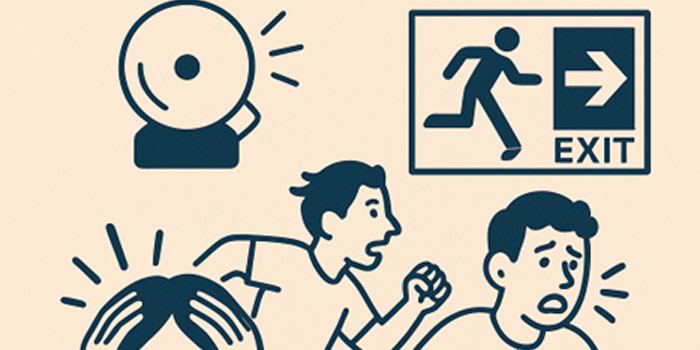You planned for smoke. You didn’t plan for screaming.
In a real emergency, it’s not the flames that get you first. It’s confusion. Misdirection. That one person who freezes in the hallway while others try to push past. It’s the surge, the indecision, the cortisol crash.
This is why psychological safety isn’t fluff. It’s the other half of real emergency planning.
People don’t behave like the plan says they will
You can have the clearest evacuation map in the world. Doesn’t matter. In crisis, the brain short-circuits.
People forget where exits are. They follow crowds blindly. Some become leaders. Others collapse.
Fight, flight, or freeze kicks in—and most building plans assume everyone will calmly walk to the right stairwell. That’s not how brains under threat operate.
Stress flips the script
Under pressure, vision narrows. Fine motor skills drop. Verbal processing weakens. People shout or go silent. They forget instructions they knew by heart ten minutes earlier.
Planning for emergencies means planning for the human reaction to emergencies.
Calm isn’t an accident. It’s a system.
Want people to behave better in panic? Design for it.
That starts with drills. Not calm, predictable ones. Stress drills. Timed drills. Drills with curveballs.
Make the building itself a source of calm.
Clear, unambiguous signage. Color-coded exit paths. Lighting that guide—not just illuminates. Visual cues that don’t require reading or thinking.
Clarity lowers panic. Simplicity saves lives.
In a real emergency, a confusing sign is a trap. A poorly marked exit is a hazard. Instructions written in soft corporate tone? Useless.
Use big fonts. Arrows, not sentences. Symbols over words. The messaging should be clear even through smoke and adrenaline.
Preload the behaviour before the emergency
Psychological safety isn’t just about comfort. It’s about giving people a mental map they can use under duress.
Repetition matters. Run drills often enough that people stop thinking. They move because it’s muscle memory.
Add cognitive load: have them evacuate while holding a coffee. Wearing headphones. After just receiving bad news.
Show them: “Even when you’re distracted, you can still get out.”
Make signage part of the environment, not an afterthought
Emergency signs should not be wallpaper. They should be part of the visual rhythm of the space.
Rotate messages. Add LED prompts that shift based on conditions. Use soundscapes to guide attention when vision fails.
Design for failure. Design for confusion. Design for the fog of fear.
Normalise emergency conversation
Most spaces treat emergency talk like a disclaimer. It’s quiet. Awkward. Skippable.
Flip that.
Talk about drills. Show off your signage. Make safety culture visible, vocal, and confident.
When people believe the space is prepared, they follow faster. When people feel guided, they move together.
Train leaders for chaos moments
Every floor should have at least one person who knows what to do when nothing makes sense.
Not just where to go—but how to speak. How to make eye contact. How to calm someone in shock. These are psychological first responders.
Invest in them. Identify them. Give them tools.
Panic spreads. So does calm.
Every person who moves with purpose reduces the ripple effect of fear. Every clear voice lowers the volume of panic.
Planning for fire is smart.
Planning for panic is essential.

